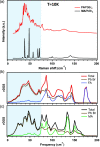Static and Dynamic Disorder in Formamidinium Lead Bromide Single Crystals
- PMID: 36722023
- PMCID: PMC9923750
- DOI: 10.1021/acs.jpclett.2c03337
Static and Dynamic Disorder in Formamidinium Lead Bromide Single Crystals
Abstract
We show that formamidinium-based crystals are distinct from methylammonium-based halide perovskite crystals because their inorganic sublattice exhibits intrinsic local static disorder that coexists with a well-defined average crystal structure. Our study combines terahertz-range Raman scattering with single-crystal X-ray diffraction and first-principles calculations to probe the evolution of inorganic sublattice dynamics with temperature in the range of 10-300 K. The temperature evolution of the Raman spectra shows that low-temperature, local static disorder strongly affects the crystal structural dynamics and phase transitions at higher temperatures.
Conflict of interest statement
The authors declare no competing financial interest.
Figures



Similar articles
-
Crystal Structure Evolution and Notable Thermal Expansion in Hybrid Perovskites Formamidinium Tin Iodide and Formamidinium Lead Bromide.Inorg Chem. 2018 Jan 16;57(2):695-701. doi: 10.1021/acs.inorgchem.7b02576. Epub 2017 Dec 26. Inorg Chem. 2018. PMID: 29278493
-
Tracking Structural Phase Transitions in Lead-Halide Perovskites by Means of Thermal Expansion.Adv Mater. 2019 Jun;31(24):e1900521. doi: 10.1002/adma.201900521. Epub 2019 Apr 29. Adv Mater. 2019. PMID: 31034108
-
Trimethylsulfonium Lead Triiodide: An Air-Stable Hybrid Halide Perovskite.Inorg Chem. 2017 Jun 5;56(11):6302-6309. doi: 10.1021/acs.inorgchem.7b00395. Epub 2017 May 16. Inorg Chem. 2017. PMID: 28509542
-
Crystal structure and spectroscopic determination of the phase transitions in methylammonium- and formamidinium bismuth iodide perovskites.Spectrochim Acta A Mol Biomol Spectrosc. 2024 Nov 15;321:124715. doi: 10.1016/j.saa.2024.124715. Epub 2024 Jun 26. Spectrochim Acta A Mol Biomol Spectrosc. 2024. PMID: 38963948
-
Intrinsic Instability of Inorganic-Organic Hybrid Halide Perovskite Materials.Adv Mater. 2019 May;31(20):e1805337. doi: 10.1002/adma.201805337. Epub 2019 Feb 17. Adv Mater. 2019. PMID: 30773706 Review.
Cited by
-
Using pressure to unravel the structure-dynamic-disorder relationship in metal halide perovskites.Sci Rep. 2023 Jun 8;13(1):9300. doi: 10.1038/s41598-023-36501-w. Sci Rep. 2023. PMID: 37291135 Free PMC article.
-
Dynamical Disorder in the Mesophase Ferroelectric HdabcoClO4: A Machine-Learned Force Field Study.J Phys Chem C Nanomater Interfaces. 2024 Dec 18;129(1):484-494. doi: 10.1021/acs.jpcc.4c06615. eCollection 2025 Jan 9. J Phys Chem C Nanomater Interfaces. 2024. PMID: 39811432 Free PMC article.
-
Colloidal Aziridinium Lead Bromide Quantum Dots.ACS Nano. 2024 Feb 6;18(7):5684-97. doi: 10.1021/acsnano.3c11579. Online ahead of print. ACS Nano. 2024. PMID: 38320982 Free PMC article.
-
On-off conduction photoswitching in modelled spiropyran-based metal-organic frameworks.Commun Chem. 2023 Dec 18;6(1):275. doi: 10.1038/s42004-023-01072-4. Commun Chem. 2023. PMID: 38110545 Free PMC article.
-
Disentangling the effects of structure and lone-pair electrons in the lattice dynamics of halide perovskites.Nat Commun. 2024 May 17;15(1):4184. doi: 10.1038/s41467-024-48581-x. Nat Commun. 2024. PMID: 38760360 Free PMC article.
References
-
- Kim Y.-H.; Kim S.; Kakekhani A.; Park J.; Park J.; Lee Y.-H.; Xu H.; Nagane S.; Wexler R. B.; Kim D.-H.; et al. Comprehensive defect suppression in perovskite nanocrystals for high-efficiency light-emitting diodes. Nat. Photonics 2021, 15, 148–155. 10.1038/s41566-020-00732-4. - DOI
LinkOut - more resources
Full Text Sources

